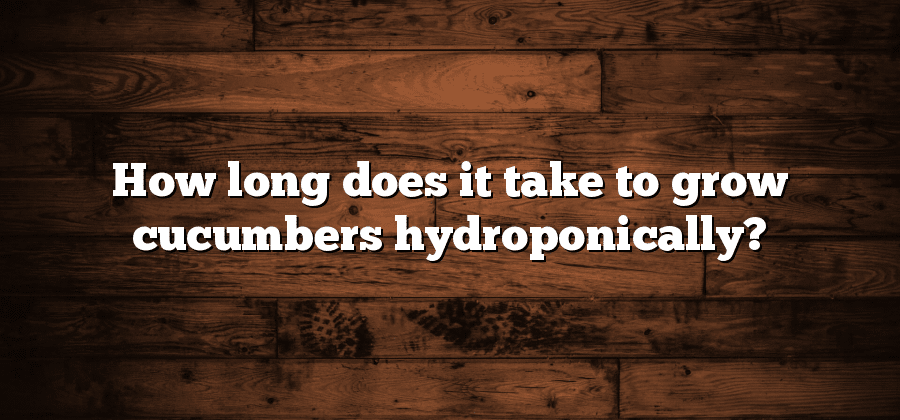Cucumber Varieties Suitable for Hydroponics
When it comes to choosing cucumber varieties for hydroponics, there are a few key factors to consider. Firstly, it is important to select varieties that are well-suited to the conditions of hydroponic growing. These varieties should have a compact growth habit, as space can be limited in hydroponic systems. Additionally, they should have a good tolerance to high humidity and be resistant to common pests and diseases that hydroponic gardens may encounter. Some popular cucumber varieties that have been found to perform well in hydroponic systems include ‘Diva,’ ‘Sweet Success,’ and ‘Salad Bush.’
In addition to the specific requirements of hydroponic growing, it is also important to consider the desired characteristics of the cucumbers themselves. Different varieties may have different shapes, sizes, colors, and flavors. Some cucumbers are best suited for slicing, while others are better for pickling. Consider your personal preferences as well as the market demands when selecting cucumber varieties for hydroponics. Overall, choosing the right cucumber varieties is a crucial step in ensuring a successful hydroponic crop that meets your specific needs and goals.
Optimal Hydroponic Growing Conditions
To achieve optimal hydroponic growing conditions for cucumbers, several key factors must be considered. Firstly, maintaining the appropriate temperature is crucial. Cucumbers thrive when the temperature ranges between 70-80°F (21-27°C) during the day, and slightly cooler at night. Additionally, providing adequate ventilation within the growing area is essential to prevent the build-up of heat and humidity, which can lead to disease and pest issues.
In addition to temperature and ventilation, ensuring proper lighting is vital for successful cucumber cultivation in hydroponics. Cucumbers require approximately 12-16 hours of light per day, ideally provided by high-intensity discharge (HID) lamps such as metal halide or high-pressure sodium lights. These types of lighting systems help to mimic natural sunlight, promoting healthy growth and development. Achieving the right balance of light intensity and duration is key to maximizing cucumber yields in a hydroponic setup.
Germination and Seedling Stage
Cucumber seeds require specific conditions to germinate and develop into healthy seedlings. Adequate moisture, warmth, and oxygen are crucial for successful germination. The ideal temperature range for cucumber seed germination is between 70-95°F (21-35°C). Placing the seeds in a controlled environment such as a germination tray with a clear lid can help maintain proper humidity levels. It is also important to ensure the seeds are placed at the right depth, usually about 1 inch deep, and covered lightly with soil or a germination mix for optimal growth.
Once germination occurs, the seedlings will begin to emerge from the soil. At this stage, it is essential to provide adequate light to promote healthy growth. A minimum of 14-16 hours of light every day is recommended for cucumber seedlings. This can be achieved through the use of artificial lighting, such as fluorescent or LED grow lights, or by placing the seedlings in a well-lit room or greenhouse. Additionally, maintaining a consistent temperature between 65-75°F (18-24°C) will help the seedlings establish strong roots and develop sturdy stems. Regular watering is also crucial during this stage, ensuring that the soil remains moist but not waterlogged.
Vegetative Growth and Pruning Techniques
During the vegetative growth stage of cucumber plants in hydroponics, it is important to provide them with the optimal conditions to ensure healthy and vigorous growth. This stage is characterized by the development of leaves, stems, and roots. To promote vegetative growth, it is crucial to maintain the right temperature, light intensity, and nutrient levels. Cucumber plants thrive in temperatures between 20-25 degrees Celsius, with a relative humidity of around 60%. Additionally, providing them with sufficient light for at least 14-16 hours a day will contribute to their healthy development.
Pruning is another essential technique to enhance vegetative growth in cucumber plants. By removing excess foliage and shoots, you can redirect the plant’s energy towards producing more vigorous stems and leaves. Regular pruning not only improves air circulation within the plant canopy but also reduces the risk of diseases and pests. It is advisable to prune the lower leaves and side shoots that are competing for nutrients and sunlight. However, make sure not to remove too many leaves as they are vital for photosynthesis. Pruning should be done with clean, sharp pruning shears to prevent damaging the plant.
Flowering and Pollination Process
During the flowering stage, cucumber plants undergo the process of producing flowers, which is a crucial step towards fruit development. The flowers of cucumber plants are typically yellow and have both male and female reproductive structures. Male flowers produce pollen, while female flowers have a stigma for receiving pollen and an ovary that houses the seeds. In order for pollination to occur, the pollen from the male flower needs to be transferred to the stigma of the female flower.
Pollination in cucumber plants can occur through various means, including wind, insects, or human intervention. When wind is the method of pollination, it is essential to ensure proper air circulation in the hydroponic system to allow pollen to be carried from the male flowers to the female flowers. However, in a controlled hydroponic environment, where wind is not present, artificial pollination techniques are often employed. This can be done by using a small brush or cotton swab to transfer pollen from the stamen of the male flower to the stigma of the female flower. It is important to ensure that only mature male flowers, which have open anthers and visible pollen, are used for pollination. By ensuring successful pollination, hydroponic growers can maximize fruit production and yield.






